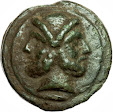Italian Coin Import Restrictions - Request For Your Help
Dear Client,
The M.O.U. (Memorandum of Understanding) between the United States and Italy that restricts the import of certain Italian coins without provenance is now up for its five year review and renewal at the U.S. State Department. If you wish to register a comment to the appropriate committee in order to protect your rights as an American Collector, you may do so through the link below. The deadline for the submission of all comments is MARCH 20, 2015 at 11:59 PM.
If the M.O.U. is extended, Americans will still be able to actively pursue collecting Roman coins, but the number of coins available for import will continue to be limited to those with sufficient pedigrees. This limitation tends to add costs and precludes certain coins from reaching American collectors that can be freely collected elsewhere.
Currently in place since January 2011 are restrictions regarding the import of Greek coins struck in Italy, Punic coins, Etruscan coins, and Republican coins struck prior to 211 B.C. This M.O.U. also covers Italian artifacts. There is however reason to believe that the current renewal will also seek to restrict late Republican and Roman Imperial coins. The current restrictions have already made it difficult to import such coins legally, and many cannot be imported at all due to lack of paperwork. New restrictions on late Republican and Roman Imperial coins would raise the same issues. This would be an unwelcome and unjustified extension of the regulations, particularly due to the fact that so many Roman coins of this later period traveled widely in antiquity. Therefore, Italy has no legitimate claim for their repatriation. In fact, an academic study submitted to the 2010 committee considering the current Italian M.O.U. lists 39 modern countries where Roman coins have been found.
Italian Finds Report
The other important point to stress is that many Roman coins that have been in collections for decades or even centuries do not have published or preserved pedigrees. This is due to their low value in the past and the relatively high cost of photographing coins in the older catalogs. Thus, both the current regulation which is up for review and especially any extension to cover later Republican and Roman Imperial coins is extremely unfair to American coin collectors who are engaged in the study and preservation of the coins. For more information on the background of this restriction, please see:http://culturalpropertyobserver.blogspot.com/2015/02/enough-already-oppose-yet-another.html by Peter Tompa, a cultural property attorney who is representing the professional coin dealer organizations (IAPN and PNG) in this matter.
If you wish to register a comment prior to the March 20 deadline, you may do so by copying this to your browserhttp://www.regulations.gov#!documentDetail;D=DOS-2015-0010-0001. Even though we have had limited success in the past with submitting comments, we have achieved some limitations on import restrictions. Our silence would be construed as complete acquiescence.
Please note that your comments will be listed on the public web site of the State Department and there is no expectation of privacy, however you are not required to list your contact information. It is best to comment in your own words, but you may freely use or adapt the following:
"Dear CPAC:
Enough is enough. This MOU should be allowed to lapse. Its negative impacts on collecting and the appreciation of Italian culture and people to people contacts, collecting brings now far outweigh any benefits. At a minimum, please free all ancient coins from restriction. Such coins are openly and legally available for sale worldwide, including within Italy itself. It makes absolutely no sense to continue to restrict American access to what Italians themselves have enjoyed since the Renaissance. Finally, please do not recommend new restrictions on Roman Imperial Coins. As the products of a great empire, these coins circulated throughout Europe, the Middle East and beyond. They "belong" not to Italy, but to us all."
Thank you for your assistance in our attempt to keep open the ability to import all Roman coins.
Ed Waddell
A link to the ACCG is:
http://culturalpropertyobserver.blogspot.com/2015/02/enough-already-oppose-yet-another.html







